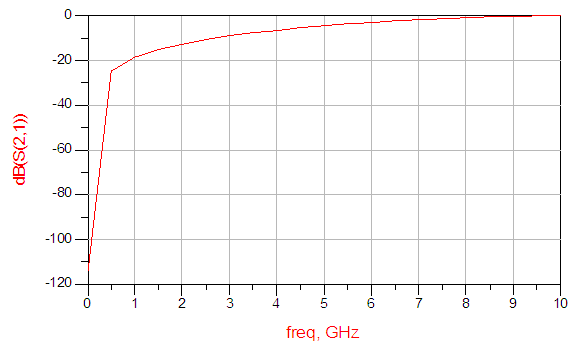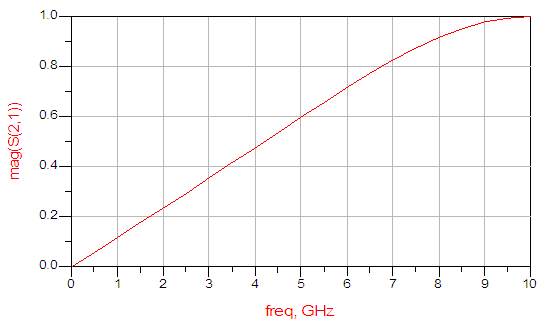Srinivasa Rao Sankranti1, Tirumala Krishna Battula2, Malleswara Rao Veera1
1Dept. of ECE, GITAM University, Rushikonda, Visakhapatnam, India
2Dept. of ECE, UCEV, JNT University Kakinada, Vizianagaram, India
Correspondence to: Srinivasa Rao Sankranti, Dept. of ECE, GITAM University, Rushikonda, Visakhapatnam, India.
| Email: |  |
Copyright © 2015 Scientific & Academic Publishing. All Rights Reserved.
This work is licensed under the Creative Commons Attribution International License (CC BY).
http://creativecommons.org/licenses/by/4.0/

Abstract
Conventional digital differentiators works efficiently up to Low frequency region only. The main purpose of the paper is to design and implement first order Al-Alaoui differentiator at microwave frequencies. Necessary derivations are carried out. The differentiator is implemented using transmission line configurations such as micro strip lines. The simulations are carried out using MATLAB and Advanced design software (ADS) environment.
Keywords:
Microwave Filter, Digital Differentiator, Stub, Micro Strip, ADS (Advanced Design Software)
Cite this paper: Srinivasa Rao Sankranti, Tirumala Krishna Battula, Malleswara Rao Veera, Design and Implementation of First Order Digital Differentiators at Microwave Frequencies, American Journal of Signal Processing, Vol. 5 No. 3, 2015, pp. 56-58. doi: 10.5923/j.ajsp.20150503.02.
1. Introduction
Digital differentiators which are are used to find the time-derivative of the incoming signal play vital role in many of the electronic systems. A digital differentiator is defined as,  . The FIR type differentiators find less use in real-time applications. Al-Alaoui have designed a IIR type digital differentiator [1-3] by the interpolation process which is given by,
. The FIR type differentiators find less use in real-time applications. Al-Alaoui have designed a IIR type digital differentiator [1-3] by the interpolation process which is given by,  . The digital differentiators are mainly implemented in circuits for low frequency applications. So, the implementation of differentiators at high frequencies is a problem of practical interest.The paper is organized as follows. Section 2 deals about design of digital filters at microwave frequencies. Implementation of Al-Alaoui digital differentiator at microwave frequencies is presented in section 3. Finally, Results and conclusions are drawn in Section 4.
. The digital differentiators are mainly implemented in circuits for low frequency applications. So, the implementation of differentiators at high frequencies is a problem of practical interest.The paper is organized as follows. Section 2 deals about design of digital filters at microwave frequencies. Implementation of Al-Alaoui digital differentiator at microwave frequencies is presented in section 3. Finally, Results and conclusions are drawn in Section 4.
2. Digital Filters at Microwave Frequencies
The Scattering Matrix which relates incident waves and emergent waves of a two port network is defined as,  | (1) |
The Chain Scattering Matrix [4] of a two port network is defined as,  | (2) |
The relation between the parameters will be,  | (3) |
The Chain Scattering Matrix for different Transmission Line configurations [5] will be calculated in this Section.
2.1. Open Circuited Transmission Line
Consider a Transmission Line with Open Circuited Stub. Let the length of the stub and transmission line be  , where
, where  is the wavelength at normalized frequency
is the wavelength at normalized frequency  . If the Impedance of the Open Circuited Stub is
. If the Impedance of the Open Circuited Stub is  , then the chain scattering matrix is given by,
, then the chain scattering matrix is given by,  | (4) |
where  is the propagation constant. Let
is the propagation constant. Let  be the angular frequency and
be the angular frequency and  be the propagation delay caused by the length
be the propagation delay caused by the length  . If
. If  , then,
, then,  | (5) |
Then Equation (4) reduces to,  | (6) |
where  and
and  . If we set
. If we set  , then,
, then,  | (7) |
The digital transfer function  or
or  is given by
is given by  . So,
. So,  | (8) |
2.2. Short Circuited Transmission Line
For the short circuited stub,  | (9) |
The above Equation can be expressed in terms of  and
and  as,
as,  | (10) |
The chain scattering matrix in terms of delay  will be,
will be,  | (11) |
The digital transfer function  or
or  of a short circuited stub is given by,
of a short circuited stub is given by,  | (12) |
3. Implementation of Digital Differentiators
3.1. Implementation of Al-Alaoui Differentiator
First order Al-Alaoui digital differentiator is given by  | (13) |
 | Figure 1. Implementation using ADS Software |
Comparing Eqn. (13) with Eqn.(12),  If
If  then
then  . The designed practical filter structure using micro strips is as shown in Figure 1. The experimental setup and the layout generated are as shown in Fig.5 and 4 respectively. The magnitude and phase responses are shown in Fig.2 and 3.
. The designed practical filter structure using micro strips is as shown in Figure 1. The experimental setup and the layout generated are as shown in Fig.5 and 4 respectively. The magnitude and phase responses are shown in Fig.2 and 3.  | Figure 2. Variation of the gain of S21 |
 | Figure 3. Variation of the Magnitude of S21 |
 | Figure 4. Layout of First order differentiator |
 | Figure 5. Experimental setup |
4. Results and Conclusions
The first order microwave differentiator was constructed by using microstrip to emulate transmission lines. The shunted transmission line having a characteristic impedance of 18.75Ω and 50 Ω equivalent microstrips are placed both sides symmetrically. The simulation is performed by using Advanced Design System Software (ADS). The magnitude response of S21(f) of first order differentiator is shown in Fig.2. We generated the physical layout by using ADS The physical layout was built on FR-4 substrate. By using Network analyzer, the magnitude response of S21(f) was measured. The simulated and experimental results of a first order differentiator are in good agreement.
References
| [1] | M.A. Al-Alaoui, Novel Digital integrator and Differentiator - IEEE Electronic Letters, Vol.29, no.4, pp.376-378, Feb.1993. |
| [2] | M. A. Al-Alaoui, Novel approach to designing Digital Differentiators-IEEE Electronic Letters, Vol.28, no.15,pp. 1376-1378, Jul.1992. |
| [3] | B.T. Krishna, S. Srinivasa Rao, On design and applications of digital differentiators, 978-1-4673-5584-1/12, IEEE-ICoAC 2012. |
| [4] | D.-C. Chang and C.-W. Hsue, “Design and mplementation of filters using transfer functions in the Z domain,” IEEE Trans. Microwave Theory Tech., vol. 49, pp. 979–985, May 2001. |
| [5] | Ching-Wen Hsue, Lin-Chuan Tsai and Kuo-Lung Chen, Implementation of First-Order and Second-Order Microwave Differentiators, IEEE Microwave Theory and Techniques, vol.52, n0.5,pp.1443-1447, May 2004. |
| [6] | Ching-Wen Hsue, Tun-Ruey Cheng and Hwan-Mei Chen, A Second order Microwave Differentiator, IEEE Microwave and Wireless Components Letters, vol.13, no.3, pp.137-139, March 2003. |
| [7] | Lin Chuan Tsai, A Novel Class of Digital Filters, 2012 8th International Conference on Wireless Communications, Networking and Mobile Computing (WiCOM-2012), China, pp.1-4, September 21-23, 2012. |
| [8] | Jia,-Sheng Hong, M. J. Lancaster, Microstrip Filters for RF/Microwave Applications, John Wiley & Sons, 2001. |
| [9] | Israel Arnedo, A. Lujambio, T. Lopetegi and M.A.G. Laso, Design of Microwave Filters With Arbitrary Frequency Response Based on Digital Methods, IEEE Microwave and Wireless Components Letters, vol.17, no.9,pp.634-636, September 2007. |
| [10] | J.G. Proakis, D.G. Manolakis, Digital signal processing, principles, algorithms, and applications-3rd edition, PHI Publications, Newdelhi, 1999. |



 . The FIR type differentiators find less use in real-time applications. Al-Alaoui have designed a IIR type digital differentiator [1-3] by the interpolation process which is given by,
. The FIR type differentiators find less use in real-time applications. Al-Alaoui have designed a IIR type digital differentiator [1-3] by the interpolation process which is given by,  . The digital differentiators are mainly implemented in circuits for low frequency applications. So, the implementation of differentiators at high frequencies is a problem of practical interest.The paper is organized as follows. Section 2 deals about design of digital filters at microwave frequencies. Implementation of Al-Alaoui digital differentiator at microwave frequencies is presented in section 3. Finally, Results and conclusions are drawn in Section 4.
. The digital differentiators are mainly implemented in circuits for low frequency applications. So, the implementation of differentiators at high frequencies is a problem of practical interest.The paper is organized as follows. Section 2 deals about design of digital filters at microwave frequencies. Implementation of Al-Alaoui digital differentiator at microwave frequencies is presented in section 3. Finally, Results and conclusions are drawn in Section 4.


 , where
, where  is the wavelength at normalized frequency
is the wavelength at normalized frequency  . If the Impedance of the Open Circuited Stub is
. If the Impedance of the Open Circuited Stub is  , then the chain scattering matrix is given by,
, then the chain scattering matrix is given by, 
 is the propagation constant. Let
is the propagation constant. Let  be the angular frequency and
be the angular frequency and  be the propagation delay caused by the length
be the propagation delay caused by the length  . If
. If  , then,
, then, 

 and
and  . If we set
. If we set  , then,
, then, 
 or
or  is given by
is given by  . So,
. So, 

 and
and  as,
as, 
 will be,
will be, 
 or
or  of a short circuited stub is given by,
of a short circuited stub is given by, 


 If
If  then
then  . The designed practical filter structure using micro strips is as shown in Figure 1. The experimental setup and the layout generated are as shown in Fig.5 and 4 respectively. The magnitude and phase responses are shown in Fig.2 and 3.
. The designed practical filter structure using micro strips is as shown in Figure 1. The experimental setup and the layout generated are as shown in Fig.5 and 4 respectively. The magnitude and phase responses are shown in Fig.2 and 3. 



 Abstract
Abstract Reference
Reference Full-Text PDF
Full-Text PDF Full-text HTML
Full-text HTML